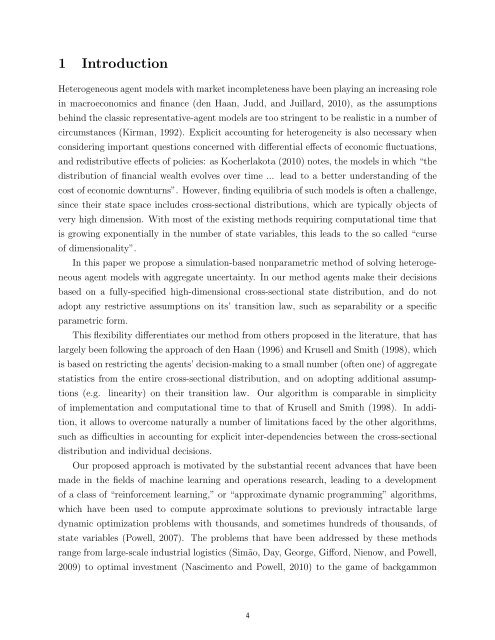You also want an ePaper? Increase the reach of your titles
YUMPU automatically turns print PDFs into web optimized ePapers that Google loves.
1 Introduction<br />
Heterogeneous agent models with market incompleteness have been playing an increasing role<br />
in macroeconomics and finance (den Haan, Judd, and Juillard, 2010), as the assumptions<br />
behind the classic representative-agent models are too stringent to be realistic in a number of<br />
circumstances (Kirman, 1992). Explicit accounting for heterogeneity is also necessary when<br />
considering important questions concerned with differential effects of economic fluctuations,<br />
and redistributive effects of policies: as Kocherlakota (2010) notes, the models in which “the<br />
distribution of financial wealth evolves over time ... lead to a better understanding of the<br />
cost of economic downturns”. However, finding equilibria of such models is often a challenge,<br />
since their state space includes cross-sectional distributions, which are typically objects of<br />
very high dimension. With most of the existing methods requiring computational time that<br />
is growing exponentially in the number of state variables, this leads to the so called “curse<br />
of dimensionality”.<br />
In this paper we propose a simulation-based nonparametric method of solving heterogeneous<br />
agent models with aggregate uncertainty. In our method agents make their decisions<br />
based on a fully-specified high-dimensional cross-sectional state distribution, and do not<br />
adopt any restrictive assumptions on its’ transition law, such as separability or a specific<br />
parametric form.<br />
This flexibility differentiates our method from others proposed in the literature, that has<br />
largely been following the approach of den Haan (1996) and Krusell and Smith (1998), which<br />
is based on restricting the agents’ decision-making to a small number (often one) of aggregate<br />
statistics from the entire cross-sectional distribution, and on adopting additional assumptions<br />
(e.g. linearity) on their transition law. Our algorithm is comparable in simplicity<br />
of implementation and computational time to that of Krusell and Smith (1998). In addition,<br />
it allows to overcome naturally a number of limitations faced by the other algorithms,<br />
such as difficulties in accounting for explicit inter-dependencies between the cross-sectional<br />
distribution and individual decisions.<br />
Our proposed approach is motivated by the substantial recent advances that have been<br />
made in the fields of machine learning and operations research, leading to a development<br />
of a class of “reinforcement learning,” or “approximate dynamic programming” algorithms,<br />
which have been used to compute approximate solutions to previously intractable large<br />
dynamic optimization problems with thousands, and sometimes hundreds of thousands, of<br />
state variables (Powell, 2007). The problems that have been addressed by these methods<br />
range from large-scale industrial logistics (Simão, Day, George, Gifford, Nienow, and Powell,<br />
2009) to optimal investment (Nascimento and Powell, 2010) to the game of backgammon<br />
2<br />
4

















